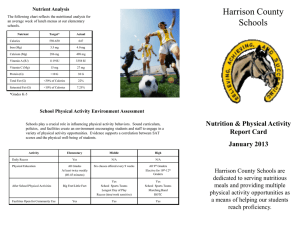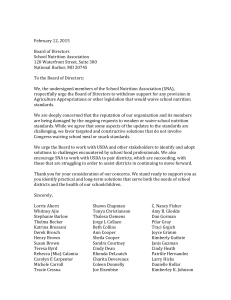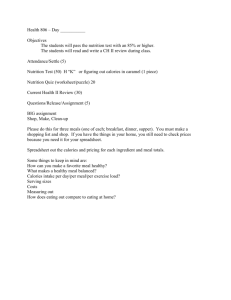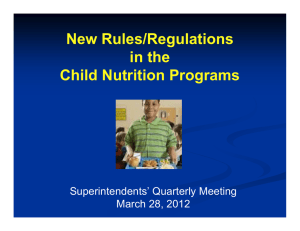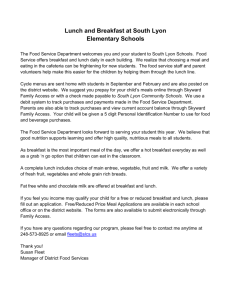Overview of New Rules/Regulations in the Child Nutrition Programs Superintendents’ Quarterly Meeting
advertisement
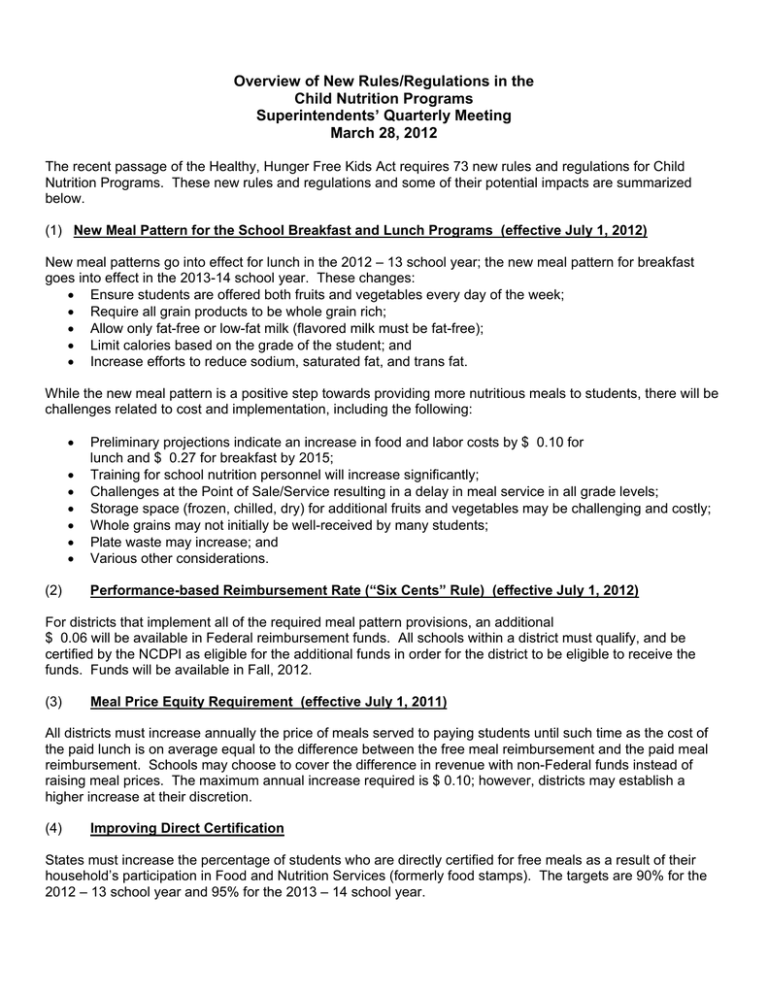
Overview of New Rules/Regulations in the Child Nutrition Programs Superintendents’ Quarterly Meeting March 28, 2012 The recent passage of the Healthy, Hunger Free Kids Act requires 73 new rules and regulations for Child Nutrition Programs. These new rules and regulations and some of their potential impacts are summarized below. (1) New Meal Pattern for the School Breakfast and Lunch Programs (effective July 1, 2012) New meal patterns go into effect for lunch in the 2012 – 13 school year; the new meal pattern for breakfast goes into effect in the 2013-14 school year. These changes: Ensure students are offered both fruits and vegetables every day of the week; Require all grain products to be whole grain rich; Allow only fat-free or low-fat milk (flavored milk must be fat-free); Limit calories based on the grade of the student; and Increase efforts to reduce sodium, saturated fat, and trans fat. While the new meal pattern is a positive step towards providing more nutritious meals to students, there will be challenges related to cost and implementation, including the following: (2) Preliminary projections indicate an increase in food and labor costs by $ 0.10 for lunch and $ 0.27 for breakfast by 2015; Training for school nutrition personnel will increase significantly; Challenges at the Point of Sale/Service resulting in a delay in meal service in all grade levels; Storage space (frozen, chilled, dry) for additional fruits and vegetables may be challenging and costly; Whole grains may not initially be well-received by many students; Plate waste may increase; and Various other considerations. Performance-based Reimbursement Rate (“Six Cents” Rule) (effective July 1, 2012) For districts that implement all of the required meal pattern provisions, an additional $ 0.06 will be available in Federal reimbursement funds. All schools within a district must qualify, and be certified by the NCDPI as eligible for the additional funds in order for the district to be eligible to receive the funds. Funds will be available in Fall, 2012. (3) Meal Price Equity Requirement (effective July 1, 2011) All districts must increase annually the price of meals served to paying students until such time as the cost of the paid lunch is on average equal to the difference between the free meal reimbursement and the paid meal reimbursement. Schools may choose to cover the difference in revenue with non-Federal funds instead of raising meal prices. The maximum annual increase required is $ 0.10; however, districts may establish a higher increase at their discretion. (4) Improving Direct Certification States must increase the percentage of students who are directly certified for free meals as a result of their household’s participation in Food and Nutrition Services (formerly food stamps). The targets are 90% for the 2012 – 13 school year and 95% for the 2013 – 14 school year. (5) Public Notification of Performance Requires districts to publicly post Administrative Review findings and make them available to the public; also requires public reporting of health inspections, local wellness policies and the nutritional quality of school meals. (6) Competitive Foods Authorizes the Secretary of Agriculture to establish nutrition standards for all foods sold and served at any time and at any location on the school campus during the school day. The proposed rule will be issued in the Spring, 2012. The final rule will be effective prior to the 2013 - 14 school year. This rule could have a significant impact on a la carte meals in NC’s public schools and will potentially affect foods provided to students in other settings like fund-raisers, special classroom events, etc. The rule will not affect events outside the school day. (7) Local Wellness Policies Districts must strengthen their local wellness policies to include stakeholder involvement and to include an evaluation component. Districts must designate one or more LEA officials to ensure accountability for the implementation and assessment of the local wellness policy. (8) Professional Standards for School Nutrition Personnel Establishes a program of required education, training and certification for all LEA Child Nutrition Directors and the State Director of Child Nutrition Programs. Other Matters of Interest (1) Verification for Cause While districts may only automatically verify a small sample of household applications for income documentation, districts are required to verify “questionable” applications for school meals when the school or district is aware (or is made aware) of additional income in the household. Districts must follow the Federal regulations for conducting “verification for cause” (these are available from the District’s Child Nutrition Administrator). Districts should consult with legal counsel in establishing the parameters of verification for cause for district employees and for determining appropriate procedures when the verification process raises issues of concern about the integrity of the application. (2) Innovative Breakfast Programs In August, 2011, the SBE passed a resolution encouraging innovative breakfast programs (breakfast in the classroom, second chance breakfast, grab-and-go breakfast) to be considered part of the instructional day as long as an appropriate educational activity is being conducted while students are eating breakfast. (3) No Kid Hungry Summer Nutrition Initiative Districts are encouraged to provide a summer nutrition program to ensure students who are food insecure have access to meals during the summer months. NC has nearly 500,000 food insecure children attending public schools.
